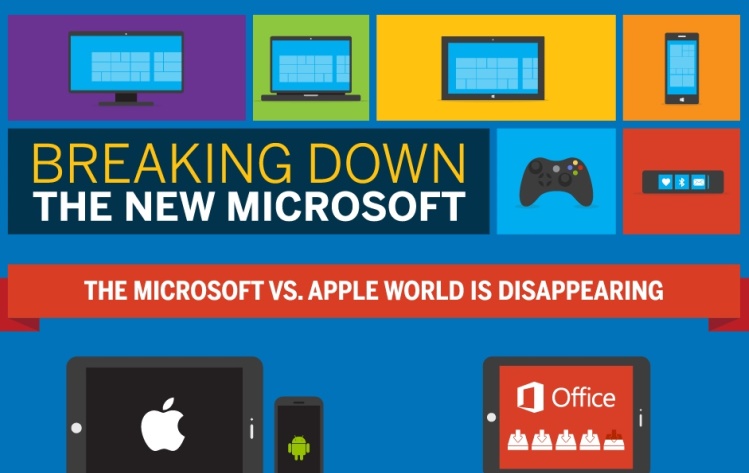Technology
Microsoft 2.0 – A New Company Under Satya Nadella

Microsoft 2.0 – A New Company Under Satya Nadella
In the late 1990s, Microsoft could do no wrong. The company, founded by Bill Gates and Paul Allen, was the most valuable in the world and Windows was selling like hotcakes. In December of 1999, the company even set a record by reaching nearly $620 billion in market capitalization at the height of the tech bubble.
The company would subsequently begin to lose its way. Bill Gates passed the torch to Steve Ballmer in 2000, but remained on as the Chief Software Architect until 2006. Later on that decade, Microsoft had its first negative earnings quarter in 23 years.
The new kids on the block like Apple, Google, and Facebook would surpass Microsoft in terms of the “cool” factor and become the de facto employment targets for computer science grads everywhere. They were building more innovative products, and hit the right market segments. The final blow was more recent, when Apple topped Microsoft’s record-setting market capitalization in absolute terms, though not yet from an inflation-adjusted perspective.
Criticism of Ballmer reached its pinnacle in 2012. A damning Forbes article cited Ballmer as “the worst CEO of a large publicly traded American company”, claiming that he had “steered Microsoft out of some of the fastest growing and most lucrative tech markets (mobile music, handsets and tablets)”. Shortly after, Bill Gates announced as Chairman that Ballmer would leave sometime within the next 12 months.
It is since then that Microsoft has made a remarkable transition, with plenty of credit to new CEO Satya Nadella at the helm. The company, which is famously known for its fiercely uncooperative nature, has started collaborating with other large tech companies including Apple.
Microsoft’s stock is now lurking near its highest point since early 2000 and the company has new and exciting products again like the HoloLens, Windows 10, Delve, Skype translator, and Sway. Nadella is also taking the company on a journey to the hot areas of technology, such as the internet of things and wearables. It’s only a year into Nadella’s journey as CEO, but the future again looks like it could be bright.
Original graphic from: UAB School of Business
Technology
Visualizing AI Patents by Country
See which countries have been granted the most AI patents each year, from 2012 to 2022.

Visualizing AI Patents by Country
This was originally posted on our Voronoi app. Download the app for free on iOS or Android and discover incredible data-driven charts from a variety of trusted sources.
This infographic shows the number of AI-related patents granted each year from 2010 to 2022 (latest data available). These figures come from the Center for Security and Emerging Technology (CSET), accessed via Stanford University’s 2024 AI Index Report.
From this data, we can see that China first overtook the U.S. in 2013. Since then, the country has seen enormous growth in the number of AI patents granted each year.
| Year | China | EU and UK | U.S. | RoW | Global Total |
|---|---|---|---|---|---|
| 2010 | 307 | 137 | 984 | 571 | 1,999 |
| 2011 | 516 | 129 | 980 | 581 | 2,206 |
| 2012 | 926 | 112 | 950 | 660 | 2,648 |
| 2013 | 1,035 | 91 | 970 | 627 | 2,723 |
| 2014 | 1,278 | 97 | 1,078 | 667 | 3,120 |
| 2015 | 1,721 | 110 | 1,135 | 539 | 3,505 |
| 2016 | 1,621 | 128 | 1,298 | 714 | 3,761 |
| 2017 | 2,428 | 144 | 1,489 | 1,075 | 5,136 |
| 2018 | 4,741 | 155 | 1,674 | 1,574 | 8,144 |
| 2019 | 9,530 | 322 | 3,211 | 2,720 | 15,783 |
| 2020 | 13,071 | 406 | 5,441 | 4,455 | 23,373 |
| 2021 | 21,907 | 623 | 8,219 | 7,519 | 38,268 |
| 2022 | 35,315 | 1,173 | 12,077 | 13,699 | 62,264 |
In 2022, China was granted more patents than every other country combined.
While this suggests that the country is very active in researching the field of artificial intelligence, it doesn’t necessarily mean that China is the farthest in terms of capability.
Key Facts About AI Patents
According to CSET, AI patents relate to mathematical relationships and algorithms, which are considered abstract ideas under patent law. They can also have different meaning, depending on where they are filed.
In the U.S., AI patenting is concentrated amongst large companies including IBM, Microsoft, and Google. On the other hand, AI patenting in China is more distributed across government organizations, universities, and tech firms (e.g. Tencent).
In terms of focus area, China’s patents are typically related to computer vision, a field of AI that enables computers and systems to interpret visual data and inputs. Meanwhile America’s efforts are more evenly distributed across research fields.
Learn More About AI From Visual Capitalist
If you want to see more data visualizations on artificial intelligence, check out this graphic that shows which job departments will be impacted by AI the most.
-

 Markets1 week ago
Markets1 week agoU.S. Debt Interest Payments Reach $1 Trillion
-

 Markets2 weeks ago
Markets2 weeks agoRanked: The Most Valuable Housing Markets in America
-

 Money2 weeks ago
Money2 weeks agoWhich States Have the Highest Minimum Wage in America?
-

 AI2 weeks ago
AI2 weeks agoRanked: Semiconductor Companies by Industry Revenue Share
-

 Markets2 weeks ago
Markets2 weeks agoRanked: The World’s Top Flight Routes, by Revenue
-

 Countries2 weeks ago
Countries2 weeks agoPopulation Projections: The World’s 6 Largest Countries in 2075
-

 Markets2 weeks ago
Markets2 weeks agoThe Top 10 States by Real GDP Growth in 2023
-

 Money2 weeks ago
Money2 weeks agoThe Smallest Gender Wage Gaps in OECD Countries













